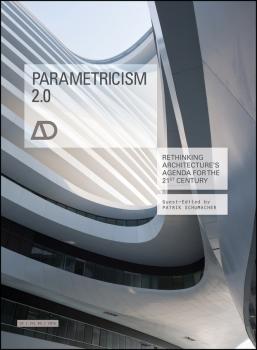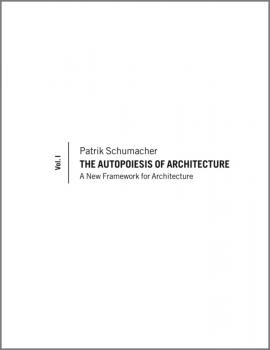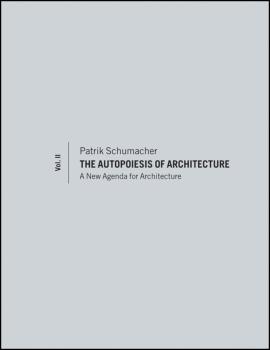ТОП просматриваемых книг сайта:
Patrik Schumacher
Список книг автора Patrik SchumacherАннотация
Parametricism is an avant-garde architecture and design movement that has been growing and maturing over the last 15 years, emerging as a remarkable global force. The tendency started in architecture but now encompasses all design disciplines, from urban design to fashion. In architecture, the style has an international following and is currently progressing beyond its experimental roots to make an impact on a broader scale, with practices like Zaha Hadid Architects (ZHA) winning and completing large-scale architectural projects worldwide. Parametricism implies that all elements and aspects of an architectural composition or product are parametrically malleable; and the style owes its original, unmistakable physiognomy to its unprecedented use of computational design tools and fabrication methods. All design parameters are conceived as variables that allow the design to vary and adapt to the diverse, complex and dynamic requirements of contemporary society. Although Parametricism has been talked about and hotly debated for a number of years, so far there has been no publication dedicated to Parametricism. The issue is guest-edited by Patrik Schumacher, partner at ZHA, and one of the world’s most highly renowned advocates of Parametricism. Contributors: Philippe Block, Shajay Bhooshan, Mark Burry, Mario Carpo, Manuel DeLanda, John Frazer, Mark Foster Gage, Enriqueta Llabres and Eduardo Rico, Achim Menges, Theo Spyropoulos, Robert Stuart-Smith, Philip F Yuan. Featured architects and designers: Arup, MARC FORNES/THEVERYMANY, Zaha Hadid Architects (ZHA) and Ross Lovegrove.
Аннотация
Take a theoretical approach to architecture with The Autopoiesis of Architecture, which presents the topic as a discipline with its own unique logic. Architecture's conception of itself is addressed as well as its development within wider contemporary society. Author Patrik Schumacher offers innovative treatment that enriches architectural theory with a coordinated arsenal of concepts facilitating both detailed analysis and insightful comparisons with other domains, such as art, science and politics. He explores how the various modes of communication comprising architecture depend upon each other, combine, and form a unique subsystem of society that co-evolves with other important autopoietic subsystems like art, science, politics and the economy. The first of two volumes that together present a comprehensive account of architecture's autopoiesis, this book elaborates the theory of architecture?s autopoeisis in 8 parts, 50 sections and 200 chapters. Each of the 50 sections poses a thesis drawing a central message from the insights articulated within the respective section. The 200 chapters are gathering and sorting the accumulated intelligence of the discipline according to the new conceptual framework adopted, in order to catalyze and elaborate the new formulations and insights that are then encapsulated in the theses. However, while the theoretical work in the text of the chapters relies on the rigorous build up of a new theoretical language, the theses are written in ordinary language ? with the theoretical concepts placed in brackets. The full list of the 50 theses affords a convenient summary printed as appendix at the end of the book. The second volume completes the analysis of the discourse and further proposes a new agenda for contemporary architecture in response to the challenges and opportunities that confront architectural design within the context of current societal and technological developments.
Аннотация
This is the second part of a major theoretical work by Patrik Schumacher, which outlines how the discipline of architecture should be understood as its own distinct system of communication. Autopoeisis comes from the Greek and means literally self-production; it was first adopted in biology in the 1970s to describe the essential characteristics of life as a circular self-organizing system and has since been transposed into a theory of social systems. This new approach offers architecture an arsenal of general comparative concepts. It allows architecture to be understood as a distinct discipline, which can be analyzed in elaborate detail while at the same time offering insightful comparisons with other subject areas, such as art, science and political discourse. On the basis of such comparisons the book insists on the necessity of disciplinary autonomy and argues for a sharp demarcation of design from both art and engineering. Schumacher accordingly argues controversially that design as a discipline has its own sui generis intelligence – with its own internal logic, reach and limitations. Whereas the first volume provides the theoretical groundwork for Schumacher’s ideas – focusing on architecture as an autopoeitic system, with its own theory, history, medium and its unique societal function – the second volume addresses the specific, contemporary challenges and tasks that architecture faces. It formulates these tasks, looking specifically at how architecture is seeking to organize and articulate the complexity of post-fordist network society. The volume explicitly addresses how current architecture can upgrade its design methodology in the face of an increasingly demanding task environment, characterized by both complexity and novelty. Architecture’s specific role within contemporary society is explained and its relationship to politics is clarified. Finally, the new, global style of Parametricism is introduced and theoretically grounded.



